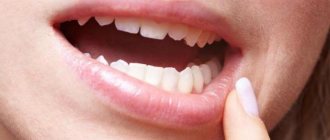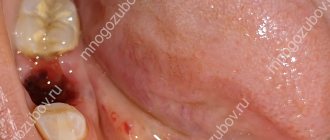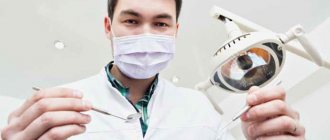Why are gum seals dangerous?
A lump on the gum after tooth extraction indicates significant damage to the soft tissue of the mucosa. They may be a jaw abnormality. This type of neoplasm is a bony bulge in the oral cavity that is constantly growing. With this pathology, the installation of prostheses is excluded, since it will rub against the growth, causing irritation.
This pathology is called exostosis. It may be accompanied by pain, sometimes there is no pain. In the first case, the tumor must be removed; in the second, the decision is made by the patient. However, it is still recommended to remove exostosis, even if it does not hurt. The reasons for this are as follows:
- such protrusions gradually grow, putting pressure on the teeth, especially the roots;
- there is a possibility of the growth degenerating into a malignant formation.
Important! It is impossible to determine the bone growth on your own, since it looks like an ordinary ball on the gum. The factor that provoked its appearance can only be found by a doctor.
When is it time to see a doctor?
It is dangerous to treat problems that arise after tooth extraction without due attention. Especially to such obvious ones as bleeding from a socket, an abscess on the gum, tissue swelling, lumps on the gum, a putrid odor. Each of them can lead to complications in the form of an abscess, phlegmon, osteomyelitis, sepsis, and end tragically.
Any problem that bothers you after tooth extraction requires medical supervision. Modern dentists have at their disposal the entire necessary arsenal of diagnostic tools and equipment to provide quick, qualified care. If a lump has formed on the gum, you need to consult a dentist in order to stop the inflammatory process as quickly as possible and create the necessary conditions for further safe healing of the hole.
Treatment of bumps on the gums
The lump with pus is removed surgically. If it is not possible to visit a dentist in the near future, medications and traditional medicine will help relieve the pain.
Treatment with traditional methods
It is recommended to disinfect the oral cavity by rinsing with a solution of furatsilin and using iodine.
To relieve pain at home, use the following remedies:
- Salt solution. Salt is used for this, preferably iodized or sea salt, which is diluted in warm water. Salt will need 4 tbsp. spoons per 1 liter of water. Before rinsing your mouth with this mixture, you need to wait until the salt is completely diluted. Before the procedure, the solution should be slightly warm. Rinse your mouth every 4 hours.
- Medicinal herbs with an antiseptic effect also provide an effect. These include eucalyptus, chamomile and calendula.
Popular traditional medicine recipes:
- Horseradish tincture with vodka. This product must be used with caution because it causes burns. To prepare the product you will need 0.5 liters of vodka and 300 g of horseradish. You need to keep it for 3 days, then dilute it with water. It is used for rinsing every 3 hours. The course of treatment is 5 days.
- Kalanchoe juice. This remedy relieves inflammation and kills germs. Rub its juice onto the area where the bumps have formed. It is also useful to chew the leaves, peeled from the film.
- Garlic tincture. This is a more effective remedy. Tincture recipe: 5 lemons are grated and mixed with 5 heads of squeezed garlic. The resulting mixture is poured with 70 ml of alcohol and kept for 5 days. Rinse your mouth with this solution every 4 hours. Recommended course - 3 days.
- A decoction of chamomile, sage and calendula flowers is known for its absorbent properties. A collection of the mentioned herbs is taken in the amount of 4 tbsp. l. and brew 1 liter of boiling water. The decoction can be used after half an hour. It is desirable that the temperature is within 36 degrees.
- A mixture of honey and salt. This remedy helps soften the hard lump and remove purulent masses. For cooking you will need 1 tsp. salt and 2 teaspoons of honey.
Traditional medicine brings minor relief and eliminates pain for a short time. They cannot replace medical care, but are only a supplement.
Treatment with medications
Medications are selected in accordance with the reasons that contribute to the popping of bumps on the gums. They are selected after diagnosis.
The problem will cease to bother you only after the cause of the pathology is eliminated.
To prevent inflammation, the patient is prescribed antibiotics after surgery. They can be in the form of tablets, injections, drops, ointments and rinses.
Immunostimulants and vitamins will not be superfluous to support the immune system in order to prevent the exacerbation of pathologies.
An antibiotic injection is sometimes given before tooth extraction surgery, which is necessary in the following situations:
- before wisdom tooth removal;
- to prevent inflammation and further infection;
- when performing a complex operation;
- with significant blood loss;
- to strengthen immunity;
- when bone tissue damage is detected;
- for rapid wound healing.
Sometimes doctors use highly concentrated antibiotic injections. This injection is given immediately after surgery, thus replacing the use of the drug with the standard method. This method reduces the likelihood of complications.
The results of antibiotic therapy are noticeable after 2-3 days. When there is no improvement, you should stop taking this antibiotic. Most likely, the cause of the pathology was determined incorrectly, and the patient will need re-diagnosis.
Important! A lump on the gum after tooth extraction, which is a hematoma, disappears on its own after a few days. If there is no improvement, you should visit a doctor.
Measures taken independently do not help eliminate the cause of the disease and relieve pain for a short time.
Reasons for appearance
Bumps on the tissues of the oral cavity grow for various reasons. From the point of view of their origin, neoplasms on the gums are of two types:
- infectious, resulting from the proliferation of bacteria that release toxins as a result of their vital activity;
- non-infectious, resulting from injury to gum tissue, and also occurring as a side reaction while taking medications.
However, the vast majority of doctors are confident that the main one is poor oral hygiene, which leads to the accumulation of plaque on the surface of teeth and gums - a source of bacterial growth.
Due to the uncontrolled proliferation of pathogenic bacteria, the formation of
tartar
, develops
caries
. These processes lead to the growth
bumps on the gums filled with pus
.
Complications after tooth extraction occur regardless of the complexity of the procedure and the qualifications of the doctor. One of them is a lump on the gum, which signals pathological changes in the tissues. Its appearance cannot be ignored, since it is a precursor to severe pathologies of the mucous membrane and gum diseases. The lesion will not resolve on its own, but timely dental care will help cope with the problem.
If a blood clot in the socket does not form after tooth extraction or falls out due to rinsing and improper postoperative care, a seal may appear on the gum. An open hole is defenseless against microorganisms that cause inflammation. They get into the wound with food, so dentists do not recommend eating anything until a blood clot has formed and tightly closed the wound.
After tooth extraction surgery, swelling with liquid contents may form. If you don't touch them, they will dissolve on their own. In some cases, the cheek swells, which is a consequence of an allergic reaction to anesthesia, infection of the wound (with deep roots), opening of an abscess during tooth extraction, or increased blood pressure during surgery.
Whatever the reasons why the compaction formed, it should not be ignored. The dentist will examine, order an x-ray, determine the nature of the lesion and prescribe the correct treatment.
Most often, a lump on the gum occurs due to diseases of the oral cavity. Usually it is localized on the upper jaw, causing discomfort and pain, sharp and aching, which does not give rest. In some cases, the problem remains hidden for a long time. The main factors that provoke growth include:
- soft tissue infection;
- trauma to the mucous membrane as a result of taking spicy, sour foods, alcohol, and a number of medications.
hard lump
If a hard lump appears, it is important to show it to the dentist. The abscess should not be heated; to alleviate the condition, you can apply ice to the cheek on the problematic side. During diagnosis, the doctor may use palpation, periapical x-rays and tomography. In case of inflammation, the surgeon opens the lesion and clears the cavity of pus.
If tooth extraction was difficult and lengthy, a soft red ball may appear on the gum. Inside there is a bloody fluid - a good environment for the spread of infection and suppuration in the future. You cannot pierce the abscess or touch it with your hands. You should also not assume that the lump will go away on its own. The most correct thing is to consult a doctor who will do everything necessary to eliminate it and, if necessary, open it.
Each case is individual. The most likely causes of the pathology are:
- Inflamed lymph node (lymphadenitis) after wisdom tooth extraction. It is characterized by local soreness, tightness in the cheek, and general malaise. Gradually the knot will shrink and become less of a concern. If this does not happen, it is important to consult a doctor.
- Hematoma. Accompanied by cyanosis, it goes away on its own within a few days. Sometimes there is pain, swelling, and fever. In such a situation, the surgeon makes an incision in the gum, washes the wound with antiseptic drugs, and installs drainage to drain the exudate. At the same time, antibacterial drugs and antiseptic rinses are prescribed. If left untreated, a hematoma can provoke phlegmon and an abscess.
- Cyst. Fibrous formation filled with fluid. Usually its appearance is accompanied by painful sensations. It should not be disturbed or pierced. The cyst is surgically removed by making an incision in the gum and clearing out the accumulated contents. Bloodless laser removal is possible, which additionally has an anti-inflammatory effect and prevents further tissue infection. If left untreated, the cyst may turn into gumboil.
- Periostitis (flux). A white ball on the gum filled with pus. Occurs if, after the removal of a wisdom tooth, the wound becomes infected. Microorganisms quickly reached the periosteum and caused an inflammatory process. Symptoms of flux: fever, sharp pain in the area of the extracted tooth, the appearance of a white ball on the gum. Urgent dental care is required to avoid rupture of the purulent sac and infection in the blood.
Chief physician, orthopedic dentist
Article checked by doctor
Tooth extraction is a serious surgical operation that often entails various complications. One of them is a formation on the gum in the form of a hard lump. This is a reason for concern and a second visit to the doctor. This formation signals that a dangerous pathological process is developing in the gum tissue.
In the case of a non-infectious cause, usually nothing needs to be done. Hematoma and allergic formations resolve on their own over time. If a purulent lump appears in the gum tissue, it means there is an inflammatory process going on there, which must be stopped so that there are no serious consequences for the body.
By the way. A lump that occurs for any reason is a phenomenon that demonstrates the pathology of the gum tissue. But not all of them pose immediate danger. However, they can subsequently become the root cause of serious illnesses and damage to the gums and jaw, and make prosthetics impossible.
For example, another type of gum lump is exostosis, when the formation is not soft, but bone tissue. Its growth is not directly related to tooth extraction, but the lump can grow before extraction, and will aggravate post-operative consequences. In addition, this jaw anomaly will interfere with the installation of dentures.
Regarding lumps on the gums that appear after and as a result of tooth extraction surgery, the decision on what to do with this formation is made by the doctor. Either he will advise the patient not to touch anything and wait until the growth disappears on its own, or he will open the gum if the lump is filled with pus. In episodes of exostosis, if the patient is not bothered by pain, the growth does not protrude strongly from the gingival tissue, and there is no need for prosthetics, the patient can make the decision to remove the formation.
Important! Even exostosis, which does not bother the patient, can become dangerous over time. It puts pressure on the roots of the teeth, causing a gradual shift in the dentition. And, no less seriously, it can become a malignant formation at any time.
Exostoses of the lower jaw are symmetrical
A hematoma or allergic lump should resolve on its own within a few days after surgery. If this does not happen, the formation has not decreased, but rather increased, it’s time to consult a doctor.
First, the dentist must make the correct diagnosis. There are various diagnostic methods for this; the choice depends on the individual situation of the patient.
Tooth extraction is one of the most serious dental operations, which often causes various complications.
One of the signs of the development of pathology is a hard lump on the gum. This neoplasm should not be ignored, because it can signal the activation of processes hazardous to health in the gingival tissues.
After removal
Patients often notice that a hard lump appears on the gum after tooth extraction.
If a blood clot that should have grown in the open socket comes off or does not form at all, which often happens when rinsing too often, it can get into the wound.
, causing inflammation.
This also happens when food particles penetrate the wound. It is in order to avoid this that dentists advise after this operation to refrain from eating until the bleeding stops and a blood clot has formed.
The formation of a hard white lump after tooth extraction is an extremely alarming signal and a reason to immediately contact a specialist.
Due to improper tooth extraction, hematomas may occur. They are a tumor filled with fluid.
Cones of this kind do not pose a serious danger; under no circumstances should they be pierced or disturbed in any way; if this condition is met, after a short time they will disappear without a trace.
In dentistry, there are cases when a tumor occurs in the gum area due to tooth extraction. A blood clot forms in the cavity that forms after surgery. It is he who performs the protective function. It looks like a small bump.
It happens that the protective blood clot comes off due to rinsing the mouth. As a result, the hole becomes infected and inflamed. This can also happen while eating. Therefore, after tooth extraction, it is not recommended to eat for several hours. Also, during this period of time, a clot forms and bleeding stops.
The popularity of traditional medicine is not decreasing. But dentists do not always trust her methods of fighting tumors. Because in case of serious diseases and complications, they can harm, but not cure. Folk remedies can relieve swelling, relieve pain and eliminate hematoma. But they will not help if it is a bone growth or malignant formation.
Exostosis
What should not be done if a seal is detected on the gum?
If a lump is detected on the gums, it is prohibited:
- warm the tumor;
- drink hot drinks;
- apply warm compresses;
- warm with a lamp;
- visit the bathhouse, solarium, sauna;
- overheat in the sun.
Important! Heat during the development of suppuration aggravates the swelling. The process involves nearby tissues.
Patients are also not recommended to pierce the abscess with a needle (even disinfected). This can be explained quite simply, because with such manipulations the formation can fester again. After this, the inflammation can spread to the cheeks and lips, and the pus can only be cleared through surgery and installation of drainage. In this case, damaged tissue takes a long time to heal and hurts much more.
In addition, at home it is impossible to distinguish ordinary suppuration from a malignant neoplasm and bone growth.
Prevention
To prevent the formation of cones, it is necessary to take preventive measures:
- Regularly sanitize the oral cavity. This procedure includes daily brushing of teeth 2 times. per day, use of mouthwash and dental floss.
- Adding to the diet foods enriched with calcium and vitamins C, B, PP.
- Avoid alcohol as it dilates blood vessels and can cause re-bleeding.
- After tooth extraction, it is recommended to refrain from eating for some time. It is advisable to consume viscous and liquid food.
- It is forbidden to rinse your mouth too much and repeatedly after surgery, so as not to wash out the blood clot that has formed in the damaged socket.
- Do not drink liquid from bottles as this creates a vacuum and may dislodge the blood clot.
- Visit your dentist regularly.
A hard lump on the gum after a tooth extraction procedure occurs due to infection and injury. Gum hardening caused by infection can be easily treated with medication. Sometimes it is eliminated through surgery. If you pay enough attention to oral hygiene, the occurrence of this pathology can be prevented.
Share the article on social media. networks:











